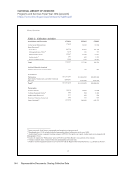54 Survey Results: Survey Questions and Responses
OCLC Sustainable Collection Services GreenGlass
Sustainable Collections tool
42. Is your library using any freely available data to make collection comparisons? N=62
Yes 8 13%
No 54 87%
If yes, please briefly describe the data set. N=8
ARL and IPEDS statistics
CUFTS, lists from vendors, DOAJ holdings
Locally developed tool by a peer university to compare databases’ coverage (similar to Gold Rush). Two
members of our committee have a privileged access for now.
Portfolio holdings
Several sources, as an example, IPEDS data
SNIP, IPP and SJR metrics, Bergstrom-McAfee Data
Usage data available from publishers/vendors
We use OCLC Expert Search to compare our holdings to those of other institutions.
43. Are there tools for data analysis that you would like to have at your institution that do not
currently exist? N=57
Yes 19 33%
No 38 67%
If yes, please briefly describe what this tool would do. N=16
A comprehensive tool to compare print and electronic holdings for purposes of overlap analysis with an
impact on budgeting, physical space, and user needs. A real-time cost/usage report with reliable data. A
tool that connects research, teaching, and learning outcomes to collection usage and management.
A fully integrated ILS
A tool that would assist in comparing freely available collection datasets from other institutions with
our own would have some value.
A tool that would provide comprehensive analysis of the entire collection.
A tool to bring various assessments together.
As before, I’m not familiar with all tools, so I can’t say what doesn’t currently exist. Much of our
analysis is based on home-grown methods rather than commercial analysis tools.
As I mentioned earlier, we are interested in a tool that would help us analyze our catalog better for our
print collection—easy reports on circulation by subject, etc.
Compare use statistics, impact factor, LJUR data and other journal metrics and information across
publisher, by call #,by research subject area. Same type of tool to compare ebook statistics from
different publishers or platforms like EBL and compare stats across the board by publisher, platform,
call #,subject areas, etc.
OCLC Sustainable Collection Services GreenGlass
Sustainable Collections tool
42. Is your library using any freely available data to make collection comparisons? N=62
Yes 8 13%
No 54 87%
If yes, please briefly describe the data set. N=8
ARL and IPEDS statistics
CUFTS, lists from vendors, DOAJ holdings
Locally developed tool by a peer university to compare databases’ coverage (similar to Gold Rush). Two
members of our committee have a privileged access for now.
Portfolio holdings
Several sources, as an example, IPEDS data
SNIP, IPP and SJR metrics, Bergstrom-McAfee Data
Usage data available from publishers/vendors
We use OCLC Expert Search to compare our holdings to those of other institutions.
43. Are there tools for data analysis that you would like to have at your institution that do not
currently exist? N=57
Yes 19 33%
No 38 67%
If yes, please briefly describe what this tool would do. N=16
A comprehensive tool to compare print and electronic holdings for purposes of overlap analysis with an
impact on budgeting, physical space, and user needs. A real-time cost/usage report with reliable data. A
tool that connects research, teaching, and learning outcomes to collection usage and management.
A fully integrated ILS
A tool that would assist in comparing freely available collection datasets from other institutions with
our own would have some value.
A tool that would provide comprehensive analysis of the entire collection.
A tool to bring various assessments together.
As before, I’m not familiar with all tools, so I can’t say what doesn’t currently exist. Much of our
analysis is based on home-grown methods rather than commercial analysis tools.
As I mentioned earlier, we are interested in a tool that would help us analyze our catalog better for our
print collection—easy reports on circulation by subject, etc.
Compare use statistics, impact factor, LJUR data and other journal metrics and information across
publisher, by call #,by research subject area. Same type of tool to compare ebook statistics from
different publishers or platforms like EBL and compare stats across the board by publisher, platform,
call #,subject areas, etc.




















































































































































































